Where to Go in Montenegro: 34 Best Tourist Places and Attractions to Visit
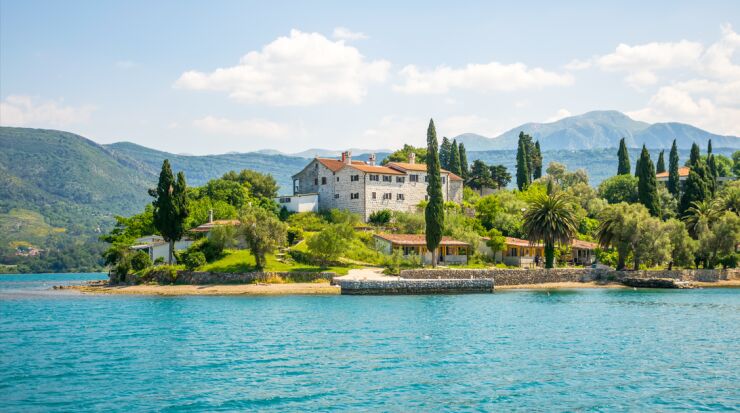
Montenegro is a real treasury full of precious objects and discoveries. Fascinated tourists will enjoy sapphire waters of the Adriatic, pearls of fortresses and palaces, emerald greenery of national parks, amethyst depths of caves and a coral bunch of islands. You will be spoiled for choice, and it will be really difficult to decide on the best attraction to see. We will be happy to help you with this and provide detailed information about the TOP-34 places to visit in Montenegro.
What attractions to visit if you don’t have much time to travel? We highly recommend to see at least one of the following best places to go in Montenegro:
- Piva Canyon. A natural masterpiece, captivating with its beauty.
- Ostrog Monastery. A sacred place where you can feel the breath of history.
- Skadar Lake. One of the most popular places among tourists.
Any of these places is a real must-see wonder of the world, even if you came to Montenegro just for a few days.
Map of Attractions
All the attractions from the review are marked on the map below.
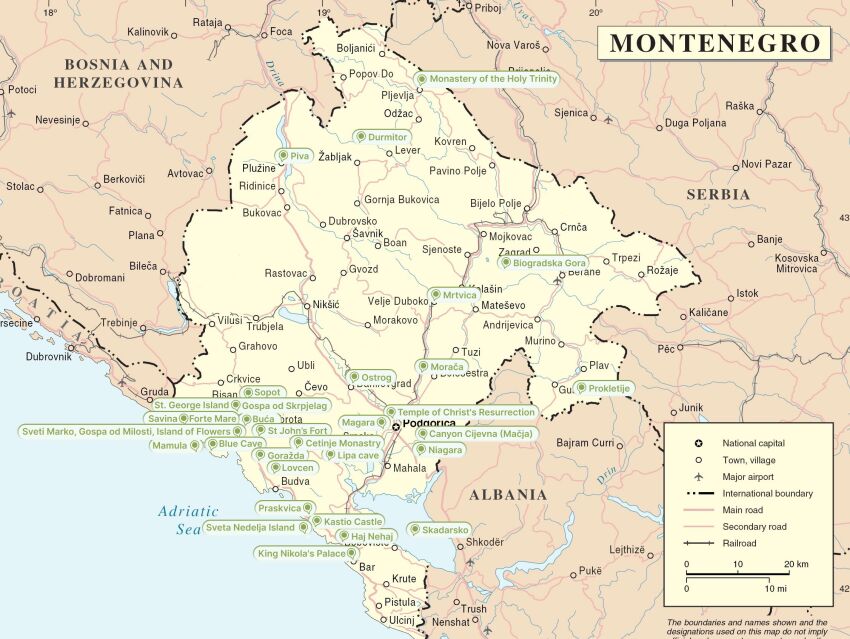
The Basis for Attractions Selection
In 2021, National Geographic Traveler (UK) included Montenegro in its list of the world's best travel destinations. The authors of this list are sure that a visit to this small European country will leave tourists no less fascinated than if they visit Canada, Japan, the UK or the USA.
According to National Geographic Traveler experts, Montenegro is one of the most inspiring places to escape reality. Environmental friendliness, abundance of natural attractions, rich history and culture, as well as a wealth of opportunities for the most exciting adventures. As travel enthusiasts, we could not help but experience this personally, so we visited Montenegro to see everything with our own eyes.
For this rating, we have selected places that are really worth visiting, and this won’t require much time. Also, these places are very popular among tourists and foreigners. So, even if you plan to spend only a few days in Montenegro, you can still visit most of these attractions. We have chosen a wide range of destinations, from canyons to palaces, to meet the needs of every tourist.
So, here are the best places to go in Montenegro, with photos, names and descriptions of how to get there. Welcome
TOP-34 Must-See Tourist Attractions in Montenegro
If you happen to visit Montenegro, limiting yourself to the beaches is like going to a lavish banquet and trying only one dish. The choice of attractions is really great, so if you go to Montenegro, you should decide in advance what to see first and which “dishes” to leave for later, if there is time.
A visit to monasteries and cathedrals will shed light on the rich spiritual life of the country. Are you attracted by the fresh air and beauty of natural creations? Enjoy the scenery of canyons, waterfalls, islands and numerous national parks.
Monasteries and Cathedrals
The history of the country goes back more than 2.5 thousand years, and most of this time Montenegro was Orthodox. No wonder that there are so many sacred places here. Many of them are located far from civilization and getting to them is a challenge. However, the most prominent cathedrals are open to tourists and pilgrims. The following places are the main attractions of Montenegro, photos of which have spread all over the world.
1. Ostrog Monastery (Danilovgrad)
Ostrog is a monastery complex located in the mountains near Podgorica.
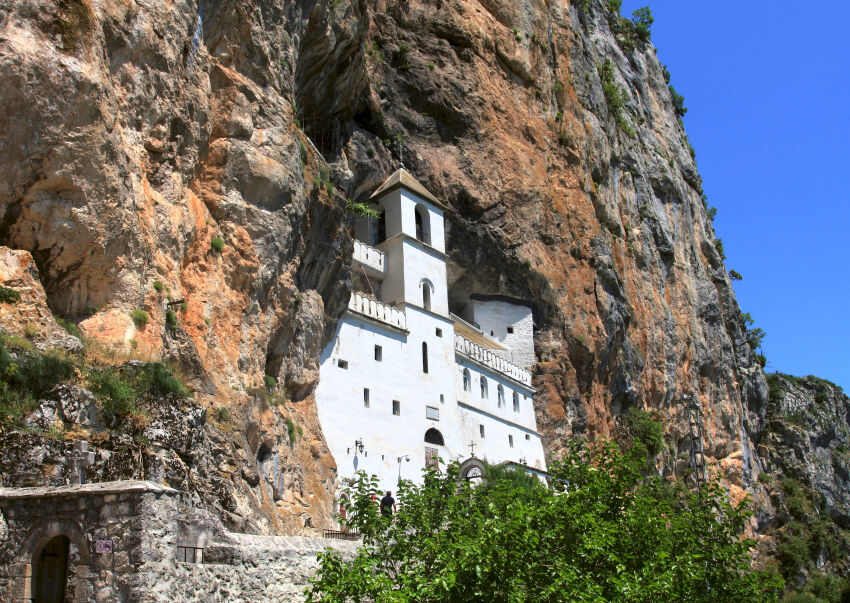
Ostrog is the most famous monastery not only in the Balkans, but also in Europe. By the way, it is still active. The complex was founded in the XVII century by Saint Basil of Ostrog, whose relics are now kept on the territory of Ostrog. The remains of other martyrs are also buried here.
The complex consists of two monasteries — upper and lower, which are connected by a 5-kilometer serpentine road and a walking trail. The upper monastery is the most impressive one. It is located 900 meters above sea level. It is built in a rock niche and literally forms an integral unit with this rock. If you take a look at it from the road, it seems that the cathedral is levitating on the background of a rising mountain. The relics of elder Vasily of Ostrog, who spent the last 15 years of his life in the small Vedeno Church, are still kept in this place.
The lower part of the complex was constructed two centuries later than the upper monastery and was founded by Archimandrite Joseph Pavicevich. It includes the Church of the Holy Trinity, built mainly at the expense of the Russian Emperor Nicholas II, a hotel for pilgrims and cells for monks — there are about two dozen of them in the monastery at the moment.
The main shrine of the monastery is the incorruptible relics of Saint Stank, a 12-year-old shepherd boy tortured by the Turks. The child held the holy cross in his hands and refused to drop it by the order of the Turkish janissaries. To punish him, they cut off his hands. The remains of 27 defenders who defended Ostrog during the Second World War are also stored here.
How to get there. The monastery is located between Niksic and Podgorica. You can get there by bus or car. The trip from Budva will take about 2.5 hours and about an hour from Podgorica or Niksic.
Entrance is free.
2. Praskvica Monastery (Sveti Stefan)
The oldest monastery in the country.
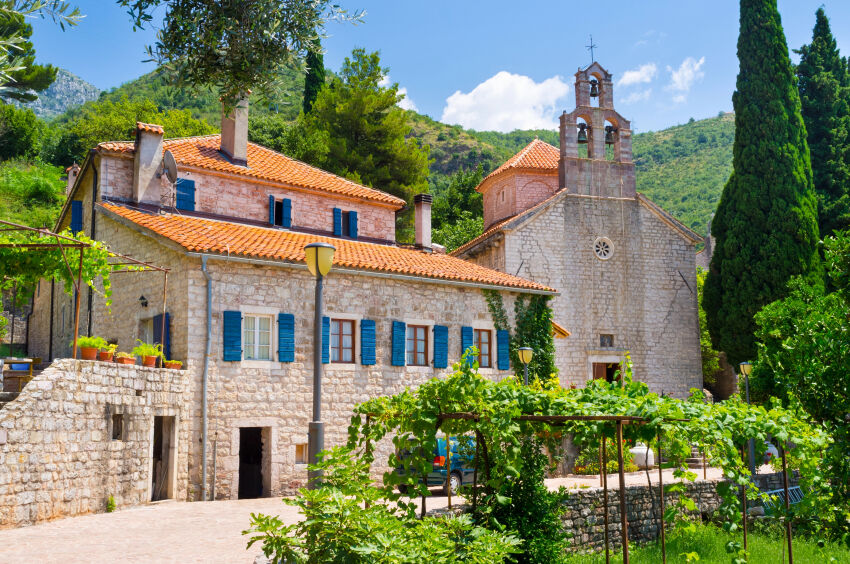
Praskvica is a small abode of solitude and relaxation. Here, in the background of ancient buildings, you will find the blooming and bearing garden planted by the monks, and depasturing livestock. The highest point of the complex reveals the stunning views of the Adriatic.
Praskvica Monastery was founded in 1050. It was rebuilt and destroyed many times throughout its existence. The most significant damage to the complex was caused by the French in 1812, when the most valuable archives that were stored there were destroyed. Its revival began in 1844. The Church of St. Nicholas was built on the foundation of the building that has been savagely destroyed by the French invaders.
How to get there. The monastery is located between Przno and Sveti Stefan, next to the highway. You can easily get there by bus or car from any resort of the country — just go to Sveti Stefan and walk a few hundred meters forward. The road from Budva will take 10-15 minutes.
Entrance is free.
3. Moraca Monastery (near Kolasin)
Medieval mountain monastery Moraca.
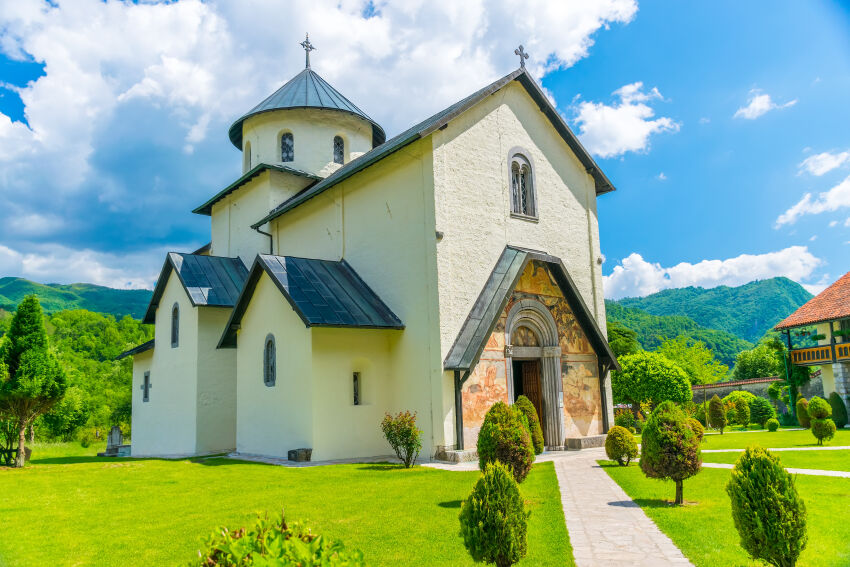
Moraca is one of the most significant and ancient shrines in the Balkans. It was founded in 1252 and is still active up to now. The monastery complex includes the Holy Assumption Cathedral Church, the Church of St. Nicholas and the monk’s cells around them.
You may see the frescoes from the XVI century inside — some of the best examples of wall painting of the Serbian and Byzantine schools. Other relics are also kept here: the hand of St. Harlampius, the Octoechos, printed in 1493, the walnut altar cross of the XVI century and an ancient handwritten Gospel. Moraca is not only part of the country's spiritual heritage, but also a magnificent example of the Romanesque architectural style with its strict, majestic and almost ascetic forms.
How to get there. By car or tourist bus along the highway with driver-friendly direction signs to the cathedral complex. The closest city to the monastery is Kolasin, which is only 25 km away. The distance to Podgorica is 47 km, Budva is 111 km away, and the road from there will take 2 hours.
Entrance is free.
4. Savina Monastery (near Herceg-Novi)
Savina Monastery is one of the oldest in Montenegro.
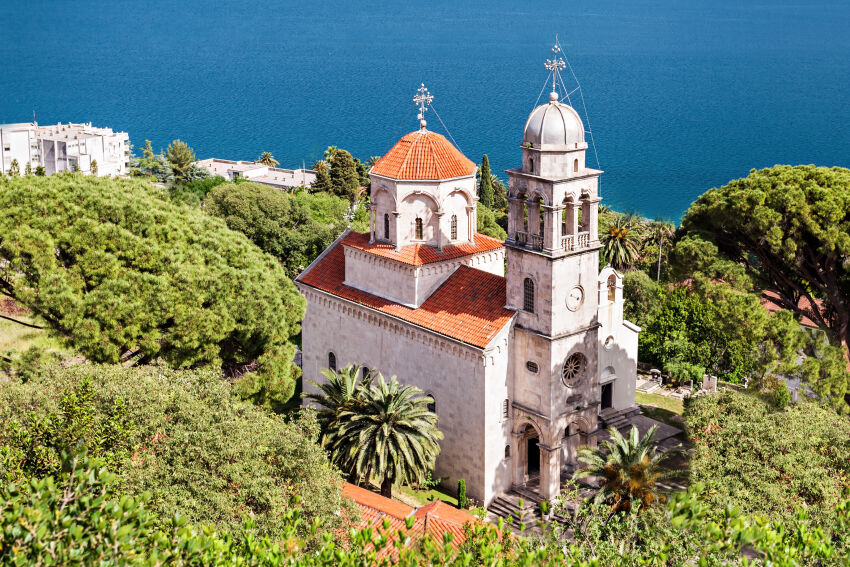
Another monastery, Savina, is located on the outskirts of the Herceg-Novi resort city. The monastery was founded at the beginning of the XI century and named after the first Serbian archbishop. The buildings of the complex are surrounded by the green trees of the Savina oak grove. The complex itself, surrounded by rocks from one side and by a powerful fortress wall from the other side, includes three picturesque churches, a building with monk’s cells and several cemeteries. The monastery is active, and more than fifty novices live there now.
The highest cathedral is called the Dormition of the Virgin Mary. It was built in the second half of the XVIII century. There’s a small cathedral of the same name on the right. The building is small — only 6 meters wide and 10 meters long. However, there are unique frescoes from the XVI century inside. People say that this is a cathedral where Emir Kusturica was baptized. The oldest building on the territory is a standing alone Church of St. Sava with a campanile.
How to get there. Savina Monastery is 2 kilometers away from Herceg-Novi, in the Savina district. You can take a taxi or walk to the entrance.
Entrance is free.
5. Cetinje Monastery (Cetinje)
Cetinje monastery, main eparchy of the Serbian Church.
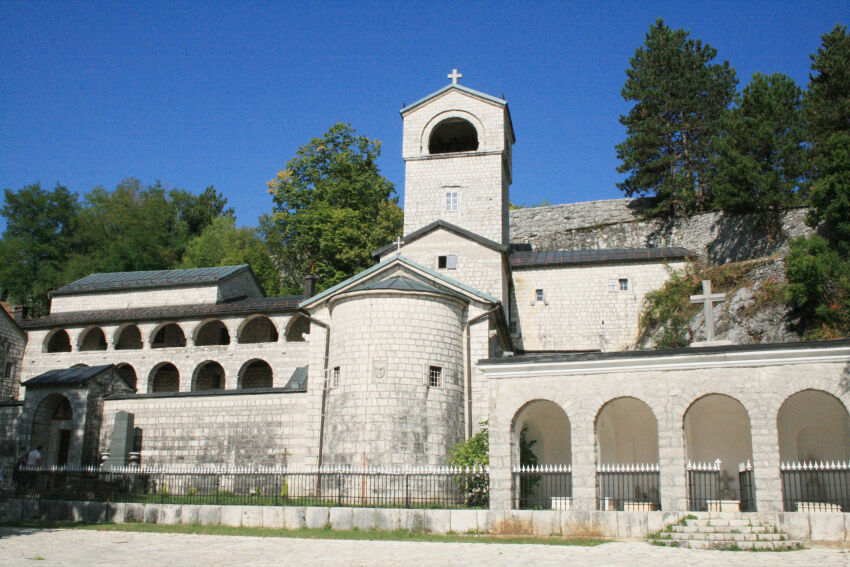
Cetinje is the historical and cultural capital of Montenegro, where princes and metropolitans have lived for centuries. The monastery was founded in 1484, but was almost wiped off the map by the Turks in 1692. Later, Bishop Danila restored the cathedral in a new location, literally two hundred meters from the old one. Stones from the ruins of a former monastery were used to build the complex. Subsequently, the complex was destroyed several more times, but was restored again at its previous location.
The picturesque monastery resembles a fortress. It is surrounded by rocks and green forests with numerous sacred relics inside: a part of the Calvary cross, miraculous icons, including the Philermos Icon of the Mother of God, painted at the beginning of this era, and the relics of holy elders.
How to get there. The monastery is located in the center of Cetinje.
Entrance is free.
6. The Holy Trinity Monastery (Pljevlja)
The Holy Trinity Monastery is a sacred place and center of spiritual life in the north of the country.
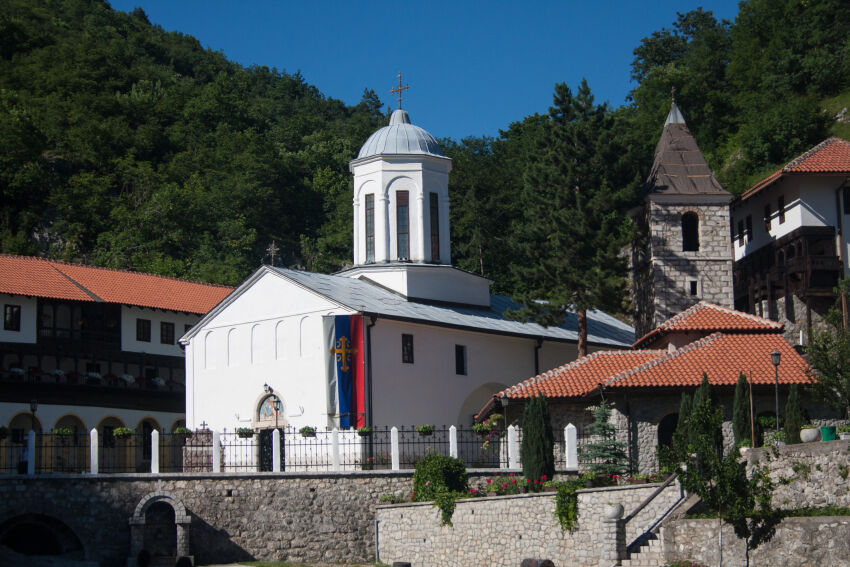
Previously, the monastery has been the largest distributor of ecclesiastical literature. In the ancient times, the monks were engaged in overwriting the church books. To this day, some of the handwritten folios with ingenious illustrations made by the monks are stored in the cathedral next to other relics, such as a priceless collection of icons and the relics of holy elders.
The date of foundation of the cathedral complex is unknown. However, it’s assumed that construction began before the Ottoman invasion in 1465. The monastery acquired its current appearance in the XVI century and, thanks to the construction skills of the successors, it preserves its look up to now.
How to get there. The monastery complex is located in the midst of picturesque hills, right next to Pljevlja, 2 kilometers away from the city. You can walk there along the convenient walking path.
Entrance is free.
7. Cathedral of the Resurrection of Christ (Podgorica)
Cathedral of the Resurrection of Christ is the third biggest Orthodox cathedral in the world.
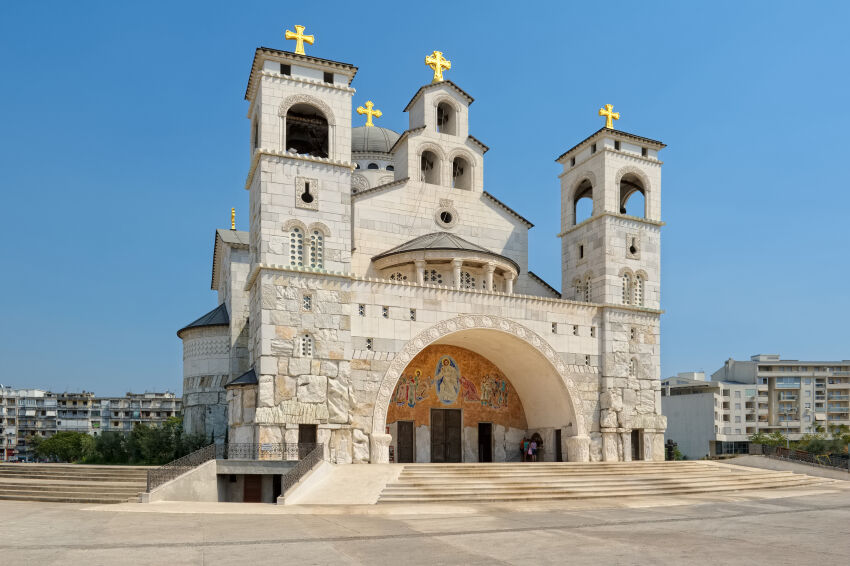
The Cathedral of the Resurrection of Christ is one of the largest in the Balkans and the largest cathedral in Montenegro. It can admit up to 5 thousand pilgrims.
Construction of the cathedral began in 1993 and was financed both from the budget, and from donations. The majestic building of the cathedral is made in the Byzantine style. Its height is above 41 meters, and the domes are decorated with gilded crosses. The campaniles of the cathedral have 17 bells, one of which weighs 11 tons.
The decoration of the cathedral impresses with an abundance of frescoes and marvelous paintings, mosaic panels and marble decoration. Podgorica Cathedral is a true pearl of Montenegro. Even if you don’t have a chance to explore other shrines, this place is a must-see.
How to get there. The cathedral is located in Podgorica, at J. Washington Boulevard, 3.
Entrance is free.
Waterfalls and Canyons
Montenegro is famous for its beautiful natural resources. Сanyons and waterfalls are a significant part of these uncreated miraculous masterpieces. The amazing sight of water flying from the sky is just mesmerizing.
8. Sopot Waterfall (Boka Bay)
Seasonal waterfall from the Sopot cave.
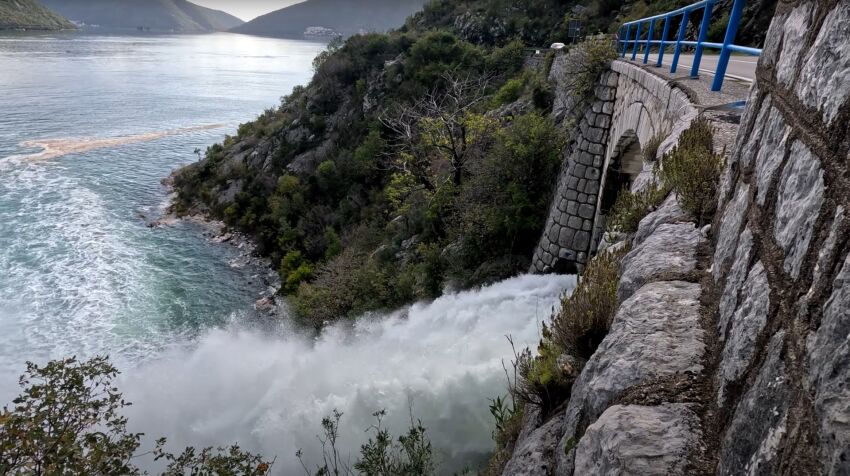
Sopot waterfall is the first in our list. Streams of water rapidly bursting out of the Sopot cave furiously rush right under the road leading to Herceg Novi and then fall down into the Boka Bay.
Except for its breathtaking beauty, the feature of this waterfall is that it shows itself only in the cold season — from late autumn to early spring. The thing is that there is a karst lake in the Sopot cave. When cold weather comes, the overflowing rainwater bursts out of the cave with a powerful waterfall. In spring, when snow melts, the waterfall “works” on melt water. So, if you happen to visit Montenegro in winter, be sure to admire this miracle of nature.
How to get there. The waterfall is located on the E80/E65 highway, 1.5 kilometers from Risan. It can be seen already from the road. Those who want to take a closer look at the rage of water, may use a staircase leading down to the water.
9. Niagara Waterfall (near Podgorica)
Niagara Waterfall on Tsievna river.
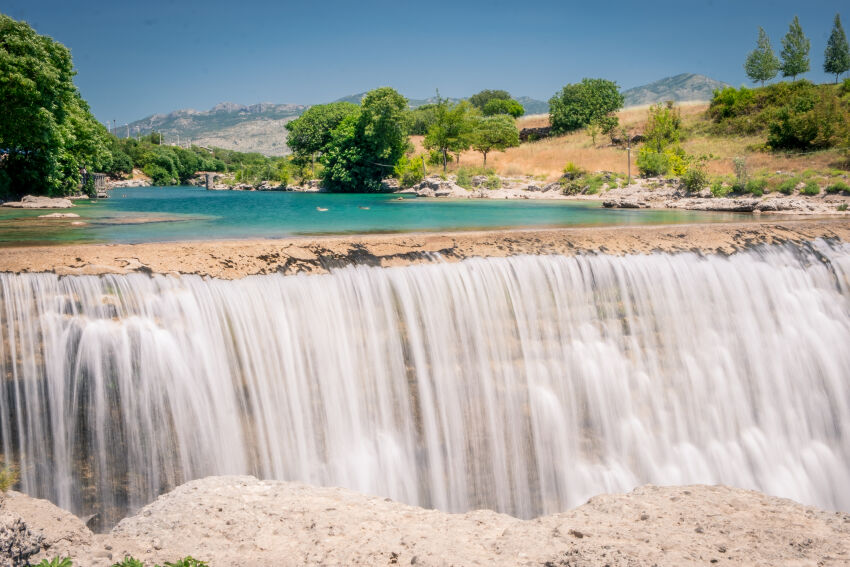
There is a beautiful Niagara waterfall in the surroundings of Podgorica. It comprises not only one waterfall, but a whole complex of falls, with the main waterfall about 10 meters high and the entire river bed wide. Rumor has it that it owes its name to emigrants who left for the United States and, when they returned home from time to time, they brought some favorite foreign names with them. Niagara waterfall is full of water in the off-season and cold season, but in summer it looks calm and peaceful. In the drought months the water flows can completely disappear.
The most interesting thing is that this majestic waterfall wasn’t created by nature. It’s an artificial complex constructed only a century and a half ago. This waterfall was supposed to provide water for a mill standing on the river. Initially, the background wall for the waterfall was of stone, and later it was concreted.
How to get there. From Podgorica on the way to Tuzla. A trip from the city center by taxi or private car will take about 10 minutes. You can also take a commuter bus to the “Tsievna” stop, and then walk for about half an hour. There is no infrastructure near the attraction, except for a small viewpoint and a restaurant.
10. Piva Canyon (Pluzine)
Piva Canyon with an artificial lake.
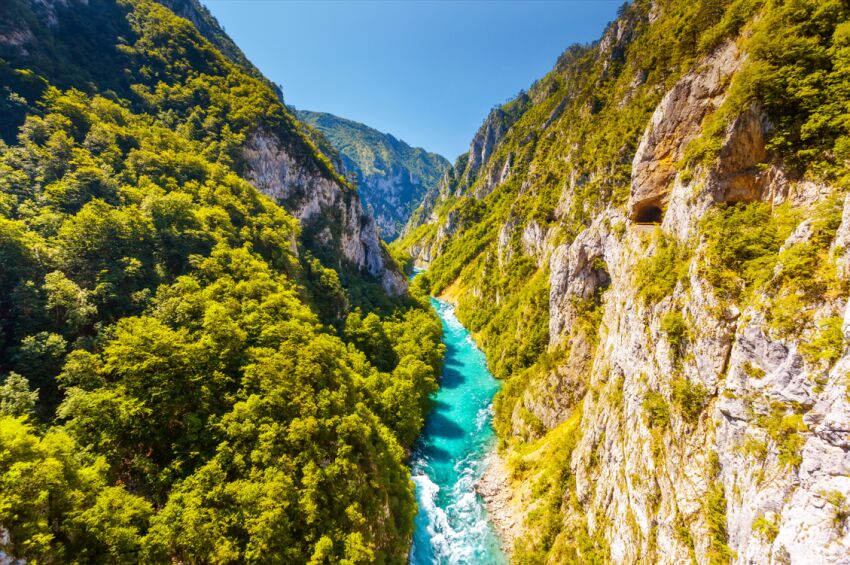
Being able to feel the spirit of Montenegro, enjoy the beauty of its nature, keep silent, contemplate, touch the cool and crystal water streams… Sounds attractive, right? If you get tired of the hot beaches, go to the Piva Canyon — one of the numerous natural masterpieces of Montenegro.
The most spectacular part of the canyon is an emerald lake 180 meters deep, formed by a 220-meter hydroelectric dam built in 1967-1975. It is located on the river of the same name, which stretches for 30 km and flows through the territory of Montenegro, Bosnia and Herzegovina, surrounded by rocks and emerald hills. Lake Piva is an excellent place not only for walks and outdoor picnics, but also for fishing (people say that the trout here is very good), swimming and boat trips.
How to get there. The lake is located near Pluzine. You can get there by car or tour bus.
11. Mrtvica Canyon (near Kolasin)
Mrtvica Canyon with spring water and waterfalls.
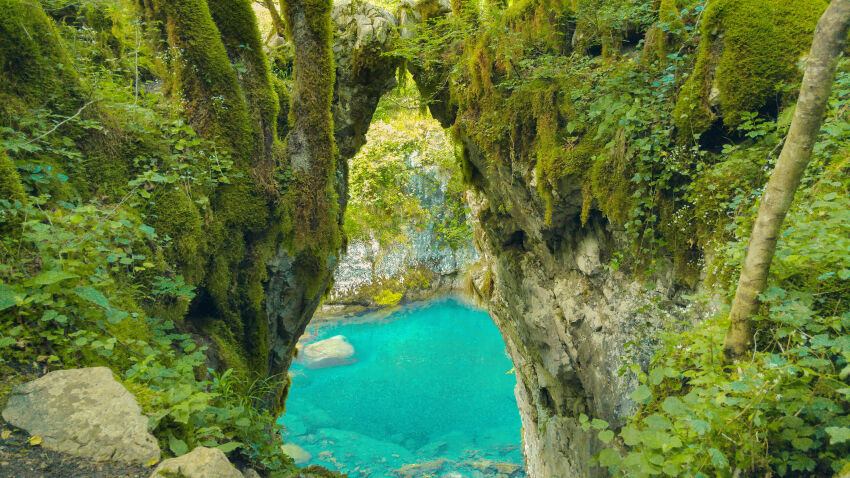
The Mrtvica Canyon is one of the best and, perhaps, the most fabulous natural attraction of Montenegro. The canyon is a 2-hour drive from Budva, but you can’t get there by car and you’ll have to walk part of the way. Be sure that every step is worth it.
Magnificent gorges and rocks, endless greenery, stones covered with bright green moss…what an incredible and magical beauty! But the most fascinating part is pure crystal water, running cheerfully over the stones, forming turquoise lakes, sparkling in large and tiny waterfalls. The best place to take a break from the hectic world and literally merge with nature to enjoy its beauty.
How to get there. The canyon is located between Podgorica and Kolasin. You can get there by car and then walk part of the way.
Fortresses and Palaces
Montenegro is an ancient country with a rich culture and fascinating history. The easiest way to enjoy these treasures and literally touch them with your fingers is to visit the magnificent palaces and ancient fortresses of this country. These stones are silent witnesses of the past. They are scattered throughout the country, and many of them are included in the UNESCO heritage list. Immerse yourself in the ancient history of Montenegro, take a breathtaking trip to the past. This adventure will definitely change you.
12. Gorazda Fort (near Kotor)
Austrian fortress Gorazda facing the bay.
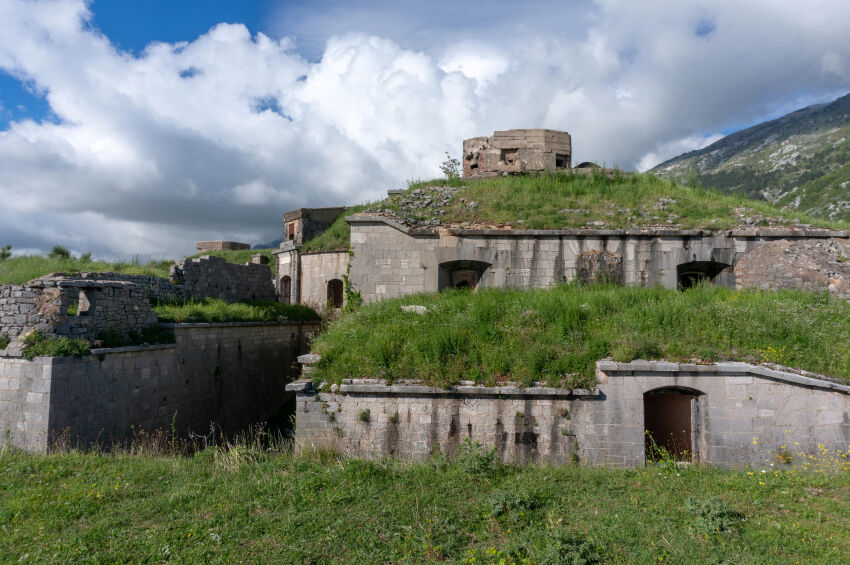
Gorazda is located at an altitude of 452 meters above sea level. If you want to make unforgettable shots of the sunset, there is no better place for it.
It is not so easy to find the fortress. It is visible only if you get closer to the arched stone walls of the fort, surrounded by a moat. This is not because the fortress is significantly destroyed, but because of the features of its design: the building literally merges with the surroundings, and finding the right angle and correct geometry is quite challenging. Everything in this place serves the purpose of effective defense.
The city was built by the Austro-Hungarians in 1886 on the coast of the Boka River. It protected the Tivat part of the Kotor Bay, controlled the road between Kotor and Cetinje and could make defensive fire for many kilometers. For its time, it was one of the best and most advantageously armed fortifications and a real masterpiece of fortification art.
How to get there. The fortress is located between Kotor and Budva. The distance to Kotor is 10 km, to Budva — 25 km. You can get there by car.
The entrance is free.
13. Sveti Ivan Fortress (Kotor)
Sveti Ivan fortress with a view of the Bay of Kotor.
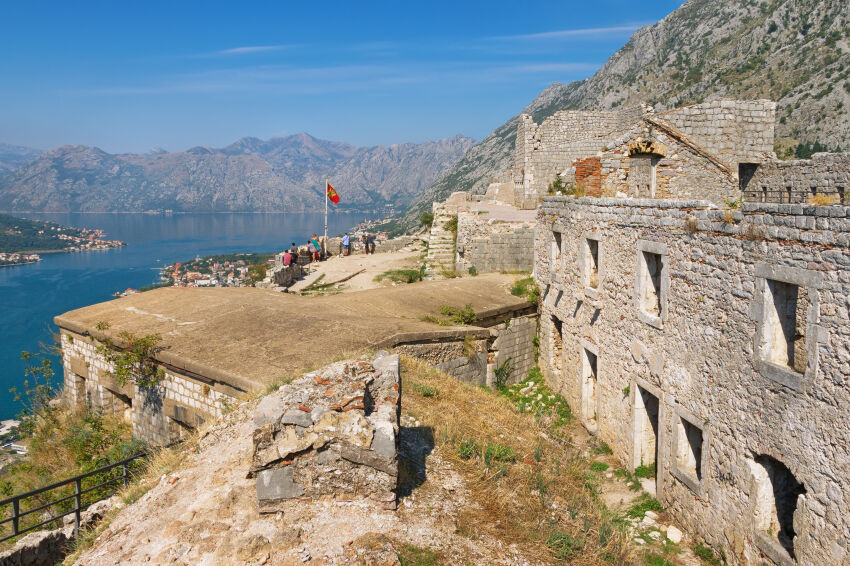
Dreaming of a trip to Montenegro, you have probably enjoyed the numerous amazing photos of the Kotor Bay in tourist guides. The best of them were made in the Sveti Ivan fortress, which still silently reigns over the city, towering 280 meters above it. Impregnable ramparts, steep staircases and thick stone walls with loopholes spread out along the surrounding mountains. This fortress was the main defender of the city and saved it from invaders many times.
During the Ottoman invasions in the XVI-XVII centuries, hundreds of ships with Turkish warriors tried to capture the city and control the Kotor Bay. Thanks to the courage of the fortress defenders and its impressive firepower, the Turks' plans failed and the city sustained the sieges.
The fort was founded by the Romans in the VI century. The construction of the fortress began in the IX century and continued until the XIX century. Its bastions shielded the city and the bay during the First and Second World Wars. Unfortunately, the earthquake of 1979 severely damaged both the city, and the fort. The city was restored, but the fortress remained partially destroyed.
How to get there. Sveti Ivan fortress is located next to Kotor, you can get there by climbing the stairs of almost one and a half thousand steps.
Entrance fee is 15 €.
14. Haj Nehaj Fortress (near Sutomore)
Haj Nehaj Fortress, formerly known as Fortezza de Spizi.
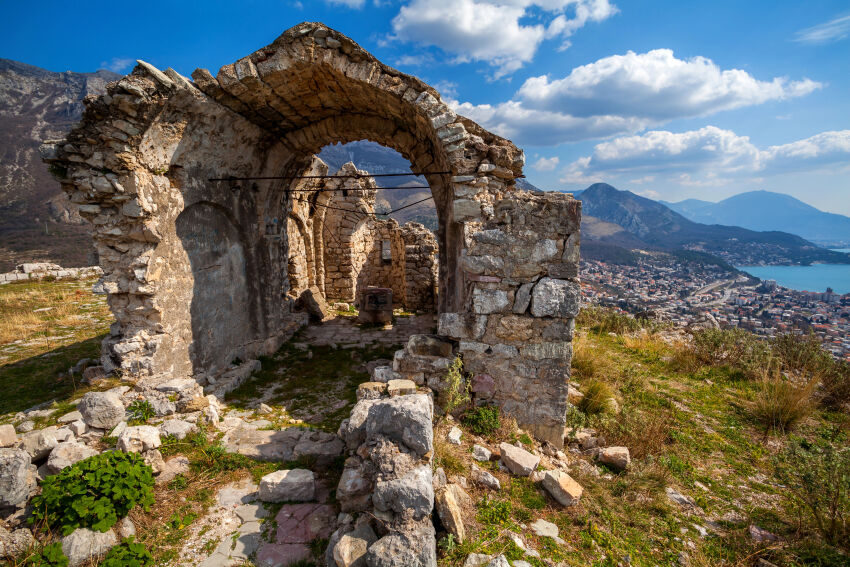
There are about one and a half dozen forts and fortresses on the territory of Montenegro. Some of them are popular among the tourists, but others are little-known to travelers. Haj-Nehaj fortress is one of them.
This monumental fortress was built in the XV century by the Venetians, as evidenced by the winged lion embossed above the entrance, which was the emblem of the Venetian Republic. The bastion is located at an altitude of 231 meters above sea level. The fortress changed hands many times, so its appearance and buildings reflect both Venetian and Turkish architectural traditions. Montenegro took possession of the fortress only in the XIX century, and during the First World War it was used by the Austrians.
The fortress is almost ruined, but the stone walls, round Turkish bastions and square towers are well preserved. By the way, you can enjoy stunning views of the Bar Riviera from the walls of Haj Nehaj.
How to get there. Haj Nehaj is about 1 kilometer away from Sutomore, you can get there by bus or car.
The entrance is free.
15. Forte Mare Fortress (Herceg-Novi)
Forte Mare is the oldest fortress in Herceg-Novi.
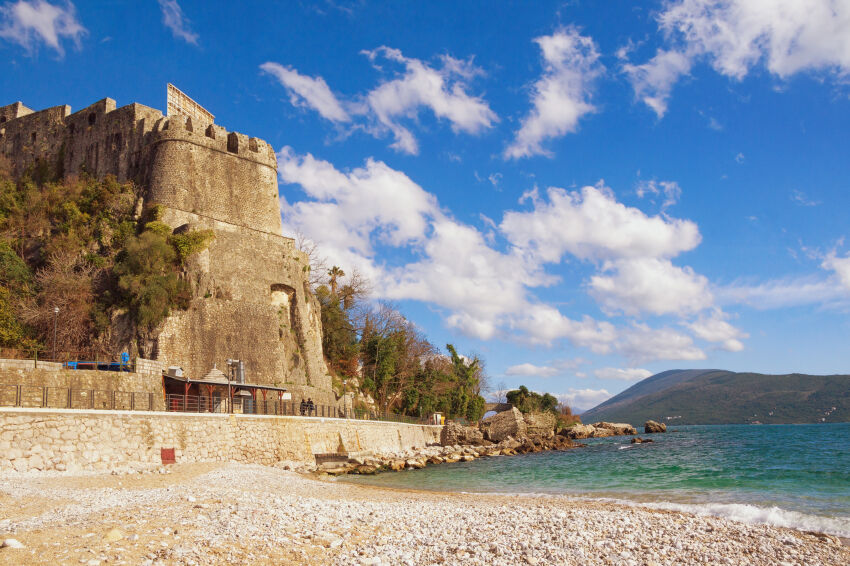
Forte Mare is a symbol of the city. The settlement began with the construction of the bastion. In addition, this is one of the most beautiful fortresses in the country, which means that it would be simply disrespectful to leave it behind. The monumental fortification was built right on the seashore.
Forte Mare, with its high and meter-thick stone walls, narrow loopholes, arched stone bridges and bastion towers, looks like a scenery to a historical blockbuster.
The fortress was built in 1382 by the founder of the city, King Tvrtko I of Bosnia. During its existence, it was constantly completed and reconstructed and each subsequent owner brought something new to its appearance. For example, the fortress walls acquired battlements and cannon loopholes while being under the Turks. By the way, the Ottomans called the fortress Jaka Kula , which meant “powerful, strong fortress.” The fortress received the name Forte Di Mare in the XVIII century, during the reign of the Venetian Republic.
How to get there. The fortress is located in Herceg-Novi. Open from April till November.
Entrance fee. The entrance fee is 2€. Entrance for children under 12 years old is free.
16. Castello Fortress (Petrovac)
Castello is a small Venetian fortress of the XVI century.
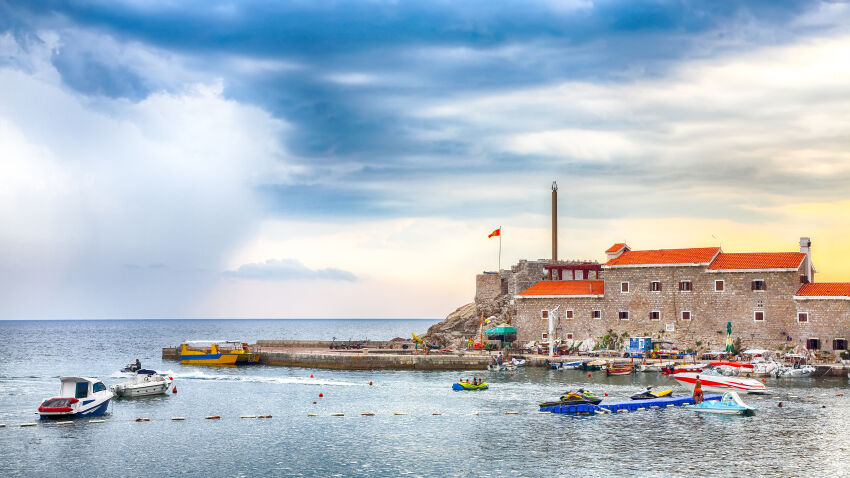
Castello is located in Petrovac. This place is the best viewpoint in the city — the view of the harbor from its walls is just breathtaking. The fortification is located on a rock and is surrounded by the sea on three sides. The fortress hasn’t served its intended purpose for a long time. There's a museum, a restaurant and even a nightclub inside, where fans of the Middle Ages hang out.
How to get there. The fortress is located in the northern part of Petrovac and can be reached on foot from any part of the city.
The entrance is free.
17. Bucha Palace (Tivat)
There’s a Tivat gallery in Bucha fortress now.
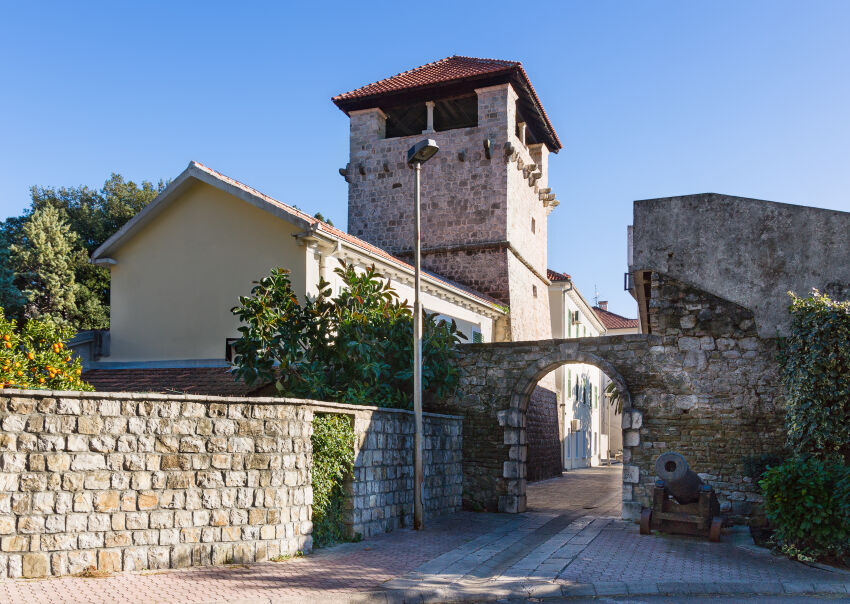
The palace, or rather the fortress of Bucha, is located in Tivat and was built in the XVII century for the noble Montenegrin Bucha family. It doesn’t look much like a palace, it is rather a fortress with multiple fortifications, Gothic tower, arched passage in a stone wall and cannon at the entrance. Even its chapel looks like a well-fortified bastion, made of large stones.
Nowadays, the palace, being the property of the city, is a cultural and historical space that is free for visiting. There is a gallery inside the main building, where exhibitions of sculptors and artists are held, as well as an ethnographic museum in the tower. There is also a summer theater on a small square in the middle of the complex, where people can enjoy plays, lectures, concerts and even movies.
How to get there. The palace is located in Tivat, near the embankment.
Ticket price should be confirmed on the spot.
18. King Nikola’s Palace (Bar)
King Nikola’s Palace is the main attraction of Bar.
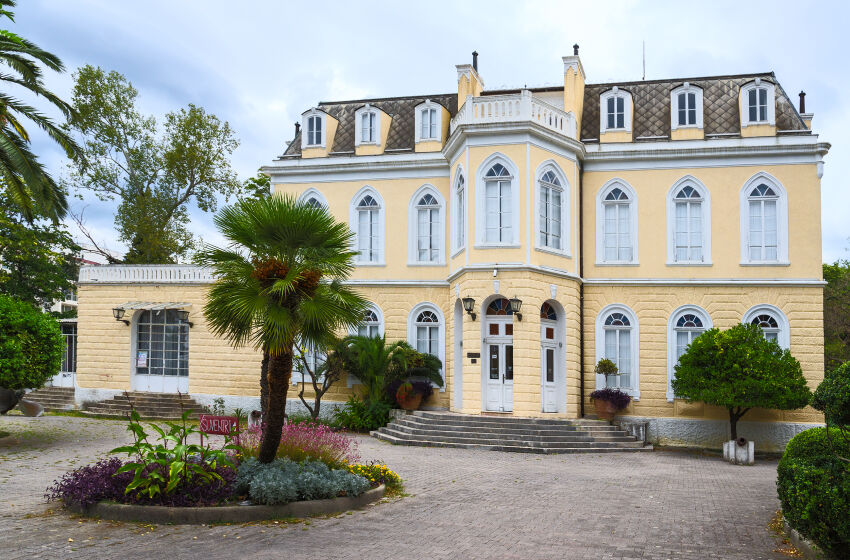
The palace is completely different from a magnificent royal residence: no stucco, marble, gilding or numerous statues. This is a small but very elegant two-story building with light walls and arched windows, surrounded by a beautiful park with rest areas. The building was built at the end of the XIX century and never belonged to King Nikola, although he visited it several times.
The most interesting thing inside the building is a local history museum, where you can get acquainted with the history of the municipality. Part of the exhibition is dedicated to the life of sailors, while other part — to the culture of the region. In particular, one of the rooms is occupied by equipment for olive oil production. Moreover, you can also find national costumes, the collection of weapons and military decoration, furniture and household items of the royal family and more. King Nikola’s Palace is open all year round, but only until 3pm in winter.
How to get there. It is located along the embankment in Bar.
Entrance fee. Entrance will cost 1€ per adult and 50 euro cents per child.
National Parks
Eco-tourism is becoming more and more popular in our urban life. Montenegro is a country that mostly profits from tourism, that’s why the authorities have made sure to satisfy the needs of every traveler. National parks of Montenegro cover 7.7% of the country’s territory and are represented by marvelous oases, where mountain peaks are framed by pine forests with healing air, and the purest glacial lakes, transparent and sparkling like the best diamonds in the world, are hidden in the gorges. The nature of Montenegro is so unique that all Montenegro national parks are under UNESCO protection.
19. Durmitor (near Zabljak)
Durmitor is the main national park of the country.
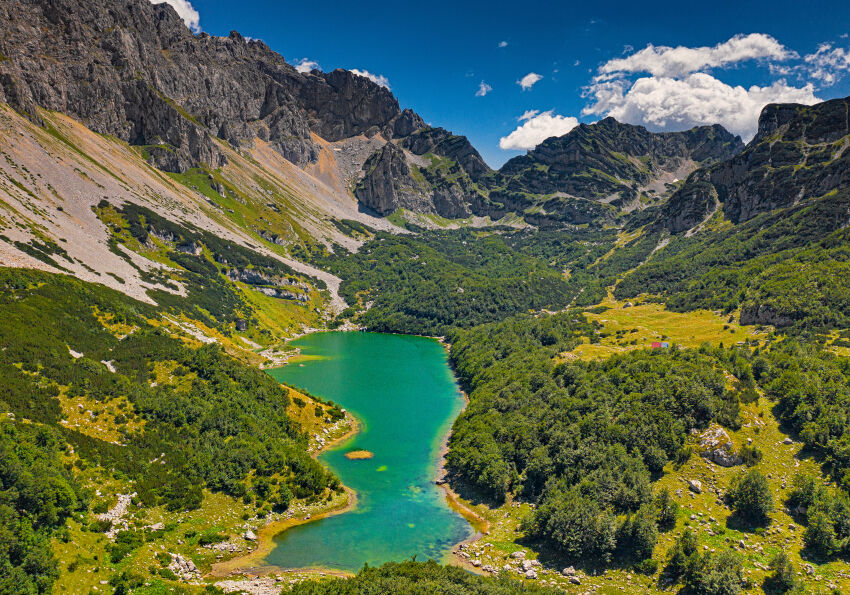
The park's area is 350 km². Most of the territory is covered by mountains and forests with unique black pine trees, which can’t be found anywhere else in the world. There are real old-timers among them that are 500 years old or more. The main and best attractions of the park are the Tara River canyon, one of the deepest in the world, and 2523 meters high Bobotov Kuk Mount.
Travelers will find numerous hiking trails, equipped campsites and tourist centers. You can go on a one-day hike or spend the entire vacation under the shadow of forests or near a glacial lake.
How to get there. The park is located in the north-west of the country, in the surroundings of Zabljak.
Entrance fee. The entrance ticket will cost 5€.
20. Lovcen (near Kotor)
Mausoleum peak at the top of Jezerski Vrh in Lovcen.
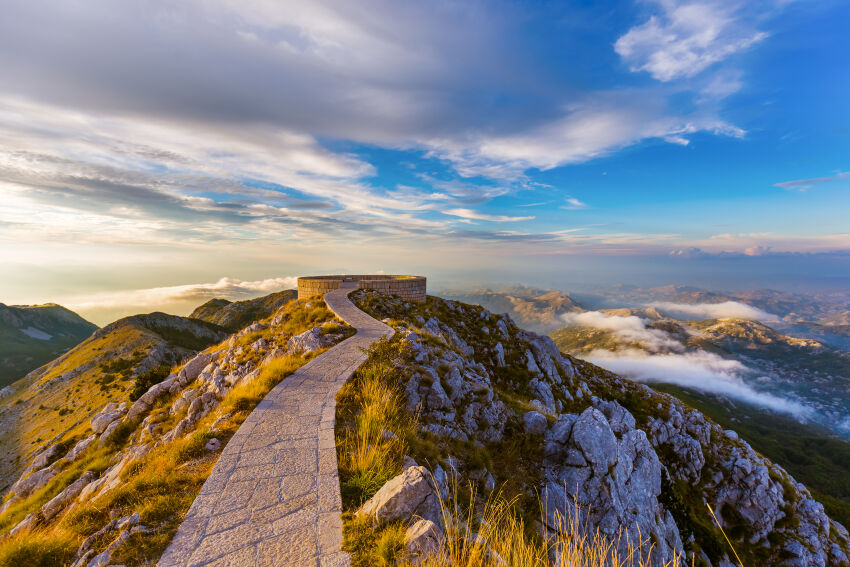
Lovcen attracts travelers with its caves and mountain steeps, craters and numerous springs with the purest water. This is also a place not for the highest, but perhaps the most famous two-peak mountain in Montenegro — Jezerski Vrh and Štirovnik.
There’s a mausoleum on the first peak with the body of Peter II Petrovich Njegos, the ruler of the country and the great poet. You will see the path leading to it. He made his last will to be buried at this very place with the view of the almost whole country. There’s also a medieval ethnic village of Njegosi on the territory of the national park. It’s another chance to get closer to the history of the country.
How to get there. By car or with a tourist group.
Entrance fee. The entrance ticket will cost 3€ per person.
21. Biogradska Gora (near Kolasin)
Biogradska gora between the Tara and Lima river valleys.
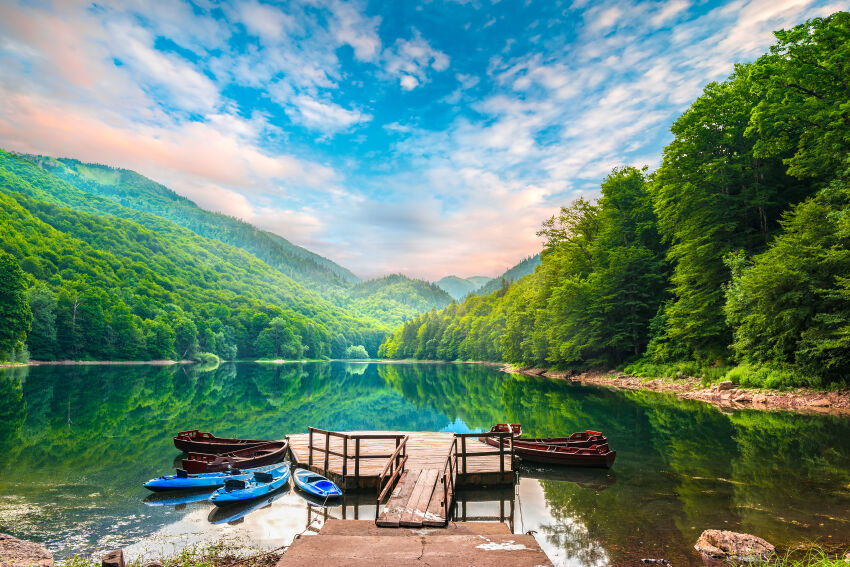
Biogradska Gora National Park is like a small lost world, hidden from civilization between picturesque mountain peaks and river valleys. Here, among the relict trees, you can breathe so easily and freely like nowhere else. The sapphire waters of the glacial lakes attract with their purity and freshness.
The main attraction of the park is its relict trees. This is one out of the three ancient forests in Europe still untouched by man. Some plants here are up to four centuries old.
How to get there. You can get to the park from Kolasin.
Entrance fee. Entrance ticket is 4€.
22. Prokletije (Plav)
Prokletije mountain range on the border with Albania.
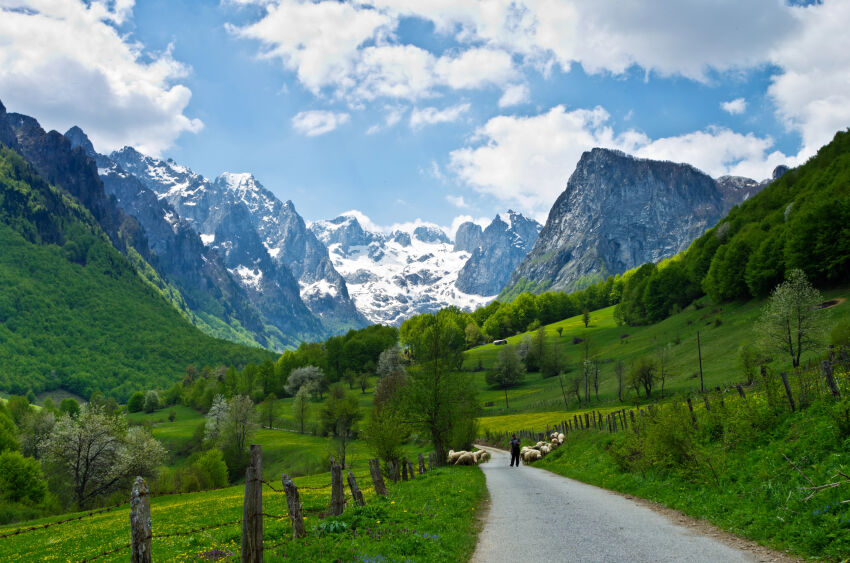
Prokletije, which is also called the Balkan Alps, is a place where the smallest national park of the country is located. Its territory is only 17 thousand hectares.
Here you can enjoy real alpine nature with its amazing monumental rocks and alpine flowering meadow. You can also swim, sail or fish in the emerald Piva Lake, the water of which warms up to 22 degrees in summer. There are also other tourist attractions here, such as monasteries with unique frescoes, ancient Orthodox churches and mosques. This is a great place to enjoy clean mountain air and get closer to the culture of Montenegro.
How to get there. By car from Plav and Gusinje.
Entrance fee. 3€ per person.
23. Skadar Lake (Virpazar, Bar)
Skadar Lake is the youngest and unusual national park of the country.
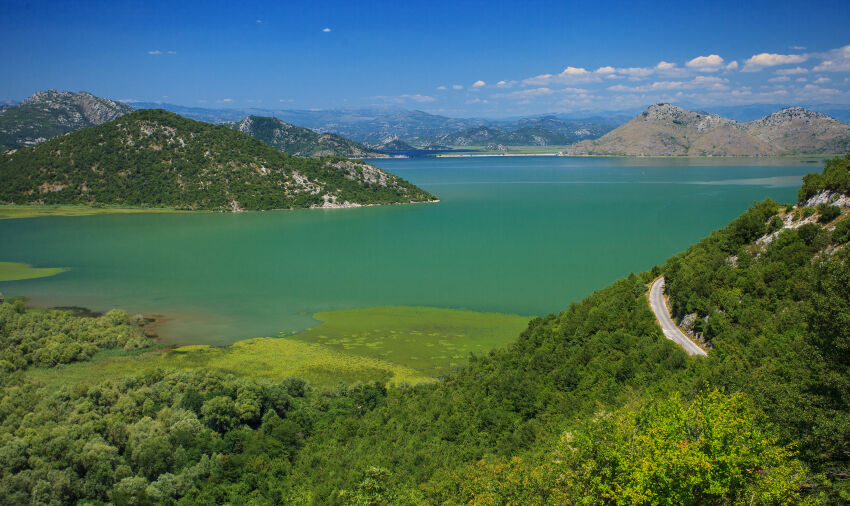
Skadar Lake almost entirely consists of a body of water that Montenegro shares with Albania. The climate here is Mediterranean, and the lake itself is shallow. Its picturesque shores are indented with cozy coves, and numerous capes are favored by rare birds. The lake is a home of an abundant fish fauna. It would be a pleasure to take a break from the noise of the resorts and breathe in the purest air free from the smog of the city.
There are many islands on the lake. Some of them attract tourists with the ruins of medieval buildings and active monasteries. Take a great opportunity to break from civilization and immerse in the culture of the country.
How to get there. The lake is located near Virpazar.
Entrance fee. Entrance to the national park is 5€ per person.
24. Holy Week Island (Petrovac)
Two tiny islands — Katic and Holy Week island.
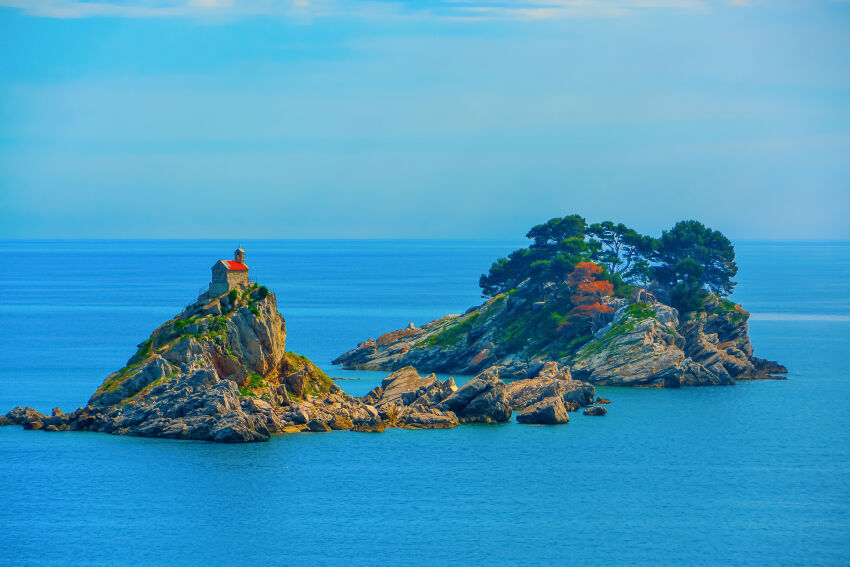
Just a kilometer of water separates Petrovac from two small islands. They can even be seen from the shore. Experienced swimmers can easily overcome the distance to the Holy Week Island and enjoy the tiny chapel rising above the island.
People say that the chapel owes its existence to sailors who survived a shipwreck on the island. In gratitude for their survival, they decided to build a church. An earthquake that struck many years ago significantly destroyed both the city, and the chapel. The city buildings were restored, but the church remained ruined.
How to get there. You can get to Petrovac from Budva by car or bus. The trip will take about half an hour.
Entrance fee. Confirm the price on the spot.
Caves
Montenegro is amazing from top to bottom. Even the beauty of its underground evokes admiration and reverence for the nature that created it. In total, there are more than 10 thousand caves in the country, but the most beautiful and popular are Lipa Сave, Blue Cave, Macja Cave and Magara Cave.
25. Lipa Cave (Cetinje)
Karst Lipa Cave is one of the most popular caves in the country.
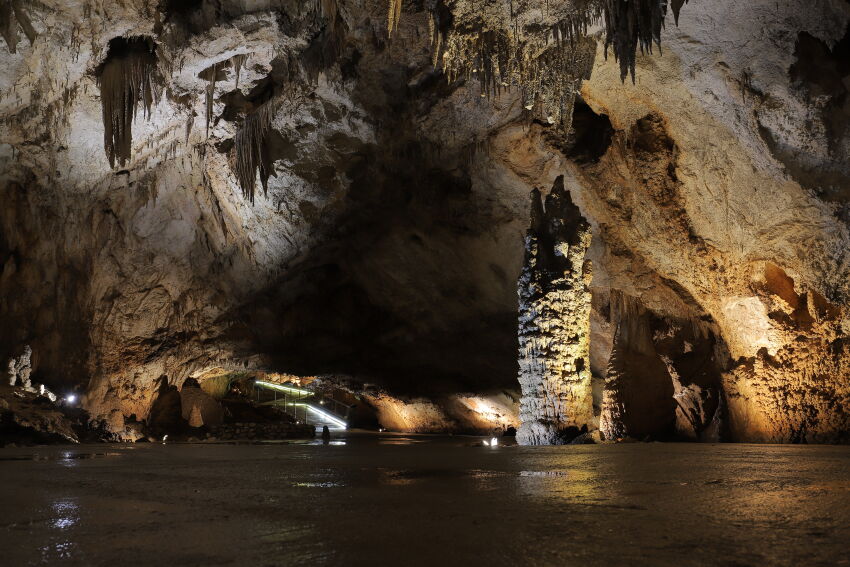
Breathtaking corridors and halls of the cave, decorated with stalactites and stalagmites, stretch for 3 kilometers. However, only 600-700 meters of this route is open to tourists. Besides, if you are properly trained, you will be offered an advanced route over 2 km long. In this case, be ready to equip yourself with a flashlight, crampons, thermal underwear and a helmet, as well as pay for the professional guide.
Individual visits to the cave are prohibited, you can only make it with a guide and as part of a group. Duration of the trip is 1 hour. The cave is open to visitors from April to November (it is often flooded in winter).
The cave was discovered back in the XIX century. Rumor has it that it was found by the brave shepherd, who went looking for his missing sheep that fell into the cave. Speculations about underground treasures of the cave reached archaeologists, and they began to explore it. The advanced route to the cave for prepared tourists begins with a rope down into the hole, where the inattentive sheep fell hundreds of years ago.
How to get there. Lipa Cave is located near Cetinje, 4.5 km away from the city center. You can get there by taxi or take a walk.
Entrance fee. Ticket price for adults starts from 14€.
26. Blue Cave (Herceg-Novi)
Underground lake in the Blue Cave on the Lustica Peninsula.
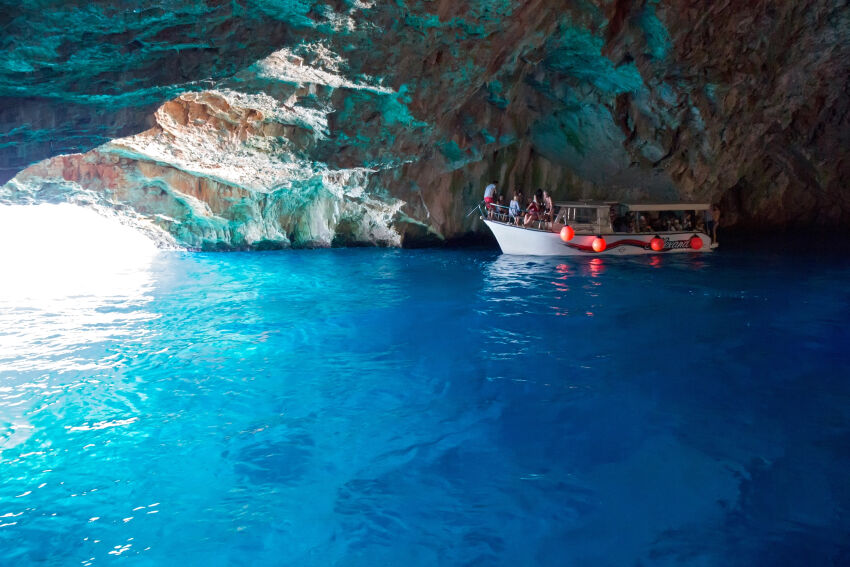
The Blue Cave owes its name to the incredible blue and almost luminous color of water that fills the 300m2 grotto. This effect is achieved due to the sun rays penetrating through the dome of the grotto. The light permeates the water (by the way, the lake is only about 5 meters deep here) and reflects from its surface, so the bizarre and mysterious blue reflections are scattered along the walls of the cave. In combination with the silence of this place you will get a truly magical view.
How to get there. You can get there only by boat or speedboat through one of the two entrances that lead to it. The cave is located in Lustica, near Herceg- Novi.
Entrance fee. The price of a trip to the cave starts from 30€.
27. Macja Cave (near Podgorica)
Macja Cave in the canyon of the Tsievna river.
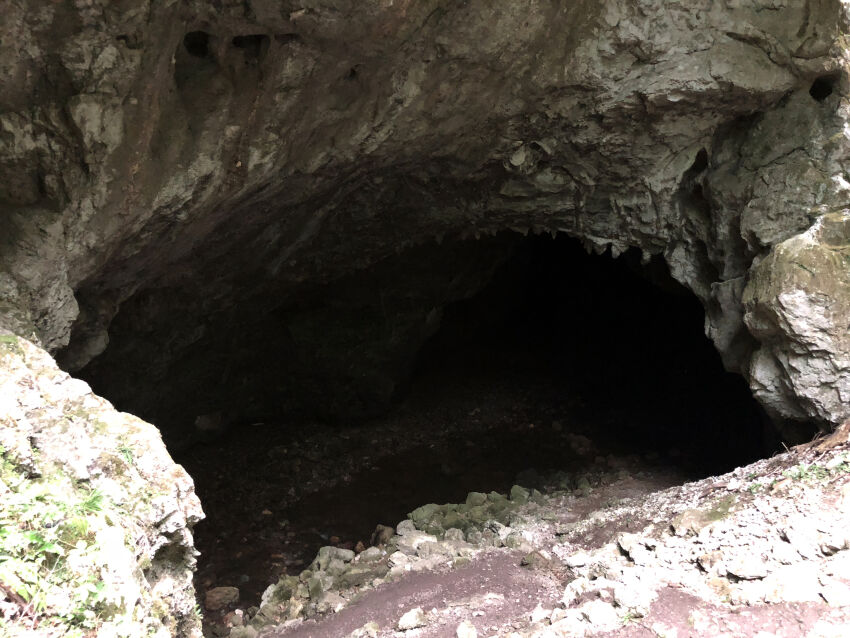
The Macja Cave (or the Cat Cave) is so tiny that it actually resembles a cat flap. It is located near the capital of Montenegro. Its compact size is more than compensated by the variety of inner decorations. The cave is filled with numerous stalactites and stalagmites of all possible sizes and shapes, and its bottom is garnished with a very deep underground lake.
How to get there. By car from Podgorica part of the way, and then on foot along the canyon of the Tsievna River. The trip will take about one hour and a half.
Entrance fee. Confirm the price on the spot.
28. Magara Cave (Podgorica)
Magara Cave is a famous underground cave not far from Podgorica.
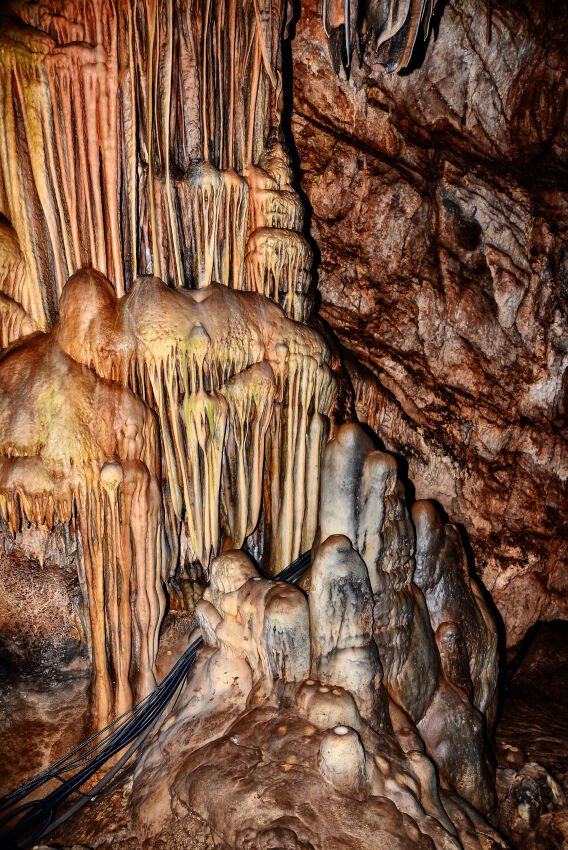
Magara was discovered not so long ago — in 1962. At the same time, locals started whispering about the supernatural energy of the cave. They said that people recovered from some physical and even mental diseases after visiting the cave. 30 years later, they even planned to turn it into the center of alternative medicine, but something went wrong.
Nowadays, tourists are attracted to Magara not by its mysterious energy, but mainly by its exceptional beauty. The cave is filled with stalactites, stalagmites and sparkling minerals. By the way, there is another attraction of Montenegro right above the cave — the Ottoman fortress Crvena Stena. You can literally kill two birds with one stone during one trip.
How to get there. Magara is located near the village of Toloshi, on the hillside, and is clearly visible from the road. You can get there by car or bus from Podgorica. The trip will take a few minutes.
The entrance is free.
Islands
Various lists of the best attractions of Montenegro always include islands of this incredible country. There are not as many of them as in Croatia, but each of them is unique and worth visiting. You may ask, how can a piece of land in the middle of the water be a tourist attraction, and if there are any remarkable places there. Well, judge for yourself.
29. St. George Island (Perast)
St. George Island or Island of the Dead in Boka-Kotor bay.

The island is located near Perast and looks truly amazing. Imagine a lush cypress grove in the middle of the water surface that grows out of the water, surrounded by a stone wall, with ancient buildings and a tower in the background.
The buildings belonged to the Benedictine Abbey of St. George, which was located on the island since the IX century. However, today you can hardly find the remains of the church. In the XVII century part of the church was destroyed by an earthquake, and the subsequent bombing completed the destruction.
There’s a cemetery on the territory of the former abbey, where the noble families and renowned sea captains of the city are buried. There is also a resort house for Catholic clergy of Montenegro. The island still belongs to the church. The territory is private and closed to visitors. However, even if you decide to observe the island from a boat or yacht, you will also get indelible impressions.
How to get there. By boat from Perast. You can explore the island by purchasing a tour or using guide services.
Entrance fee. Confirm the price on the spot.
30. Our Lady of the Rocks Island (Perast)
There’s a Church of Our Lady, a lighthouse and a museum on the island.
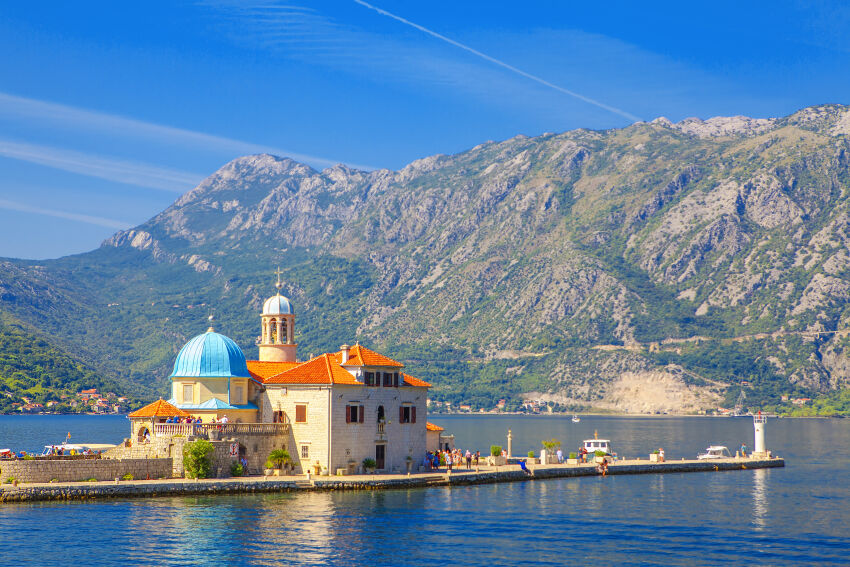
In the Bay of Kotor, literally 100 meters away from the cypress trees and stone walls of the closed Catholic island, you will find the Gospa-od-Skrpjela Island (or Our Lady of the Rocks Island), which can be easily reached from any part of the bay. Its area is only 3030m², but it is a real oasis of cultural life.
It’s interesting that most of the island is artificial. Once upon a time there was a tiny reef at this place, until one story of miraculous healing laid the foundation of a stone island. You will definitely hear the full story if you decide to visit the island.
How to get there. You can get to the island from any corner of the bay, but the easiest way is by water taxi or boat from Perast.
Entrance fee. The trip will cost from 5 to 20€ per person.
31. St. Mark’s Island (Tivat)
Stradioti is the largest island in the Bay of Kotor.
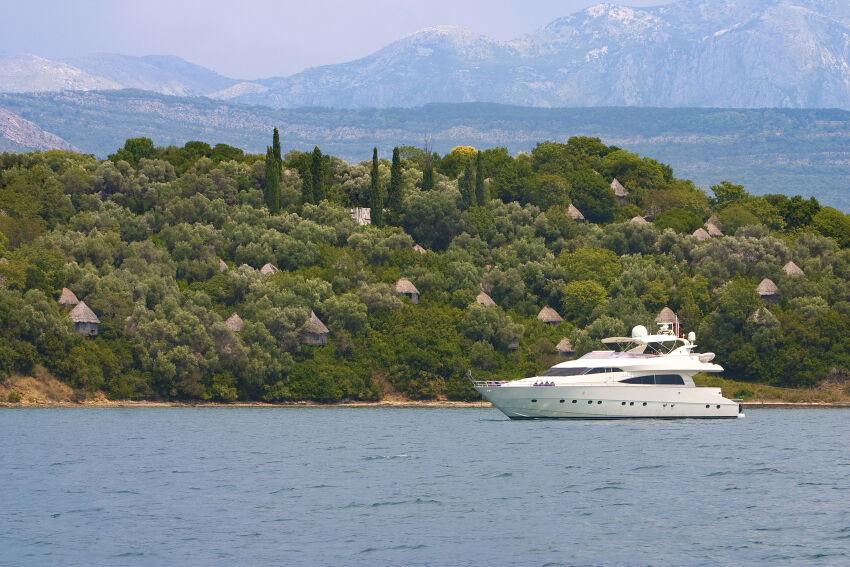
The picturesque island named after St. Mark (Stradioti) is just 2 kilometers away from Tivat. It is a part of an archipelago consisting of three islands. It coexists with the islands of Miholjska Prevlaka (Island of Flowers) and Gospa od Milo (Our Lady of Mercy).
In the past, this island used to be a center of elite cultural recreation. Foreign travelers spent their vacation in the Polynesian-style bungalows under the olive and cypress groves, which shielded the luxurious beaches from the public eyes. Today, the island is still full of greenery, but almost completely abandoned. The elite infrastructure is ruined. Take a chance to get there by boat and rest from the noise of numerous beach restaurants and hectic life of the resort.
How to get there. Take a water taxi or boat in Tivat. The trip to the island will take approximately 25 minutes.
Entrance fee. Confirm the price on site.
32. Island of Flowers (near Tivat)
Island of Flowers (Miholjska Prevlaka) and the Holy Trinity Church.
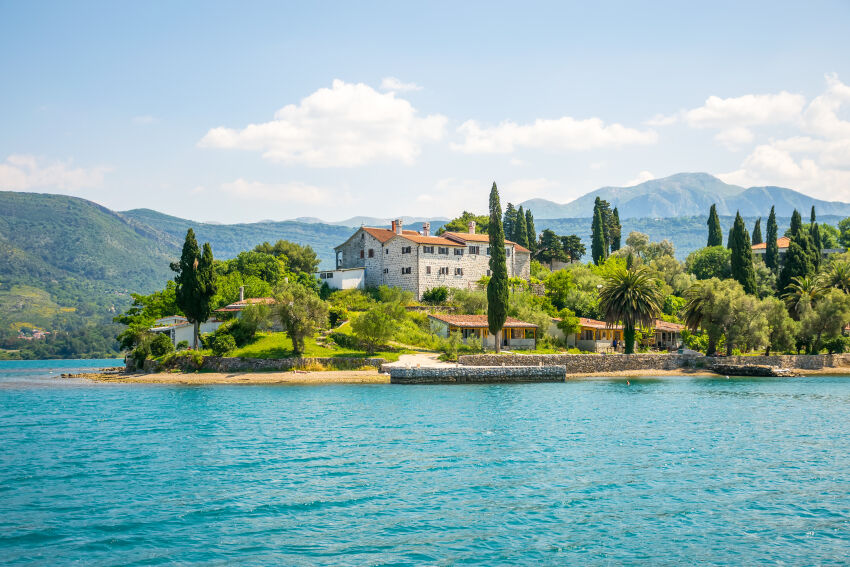
The Island of Flowers is one of the most beautiful in the archipelago and is literally surrounded by greenery. During the Middle Ages, this small part of the land had a different name — the island of St. Michael, but was later renamed when Montenegro passed to the Venetians.
The island is not only the pearl of the Montenegrin coast, but also a historical monument. In 1996, archaeologists started excavations and discovered the remains of settlements and homeware from the Bronze Age, as well as artifacts from the Roman period. You will see the ruins of an ancient monastery and cathedral in the center of the island with a Roman column carved from granite in front of it.
How to get there. The access to the island is easy — it is the only island in the archipelago, which is connected to the mainland and Tivat by a short road. You can get there on foot or by car.
The entrance is free.
33. Mamula Island (Herceg-Novi)
Mamula Island and Prevlaka and Lustica peninsulas.
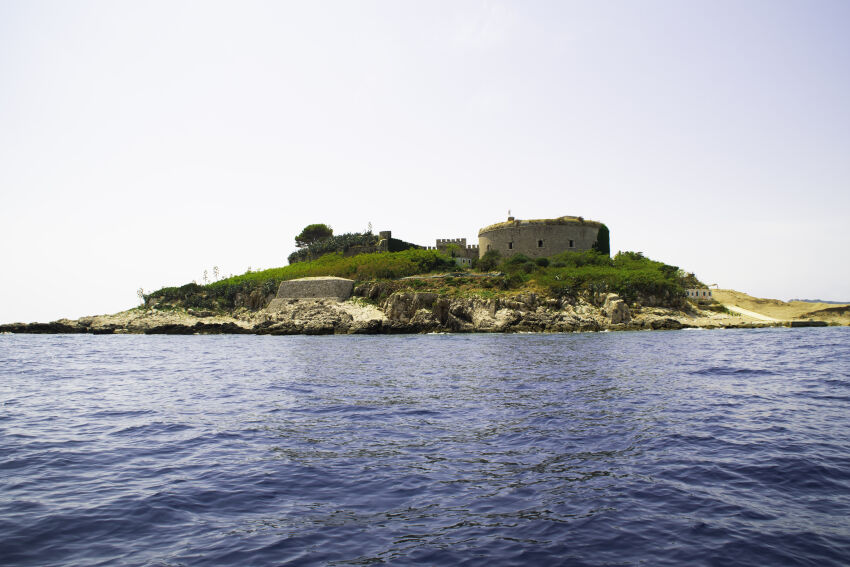
This small island — only about 200 meters across — is almost completely occupied by a well-preserved and formidable monumental Austrian fortress.
The fort, being once the defender of the bay, was built in the XIX century by General Lazar Mamula, the governor of the Kingdom of Dalmatia, which was a part of the Austro-Hungarian Empire at that time. During the world wars of the last century, the fortification was turned into a prison, so the criminals and prisoners of war were jailed here. Today the fortress is a historical monument that is protected by the state.
How to get there. You can get to Mamula Island and enjoy the well-preserved fortification only by water. You can rent a boat in Lustica, Herceg Novi or Igalo, or take a guided tour.
The entrance is free.
34. Our Lady of Mercy Island (Kotor Bay)
The smallest island of the “Holy Archipelago”.
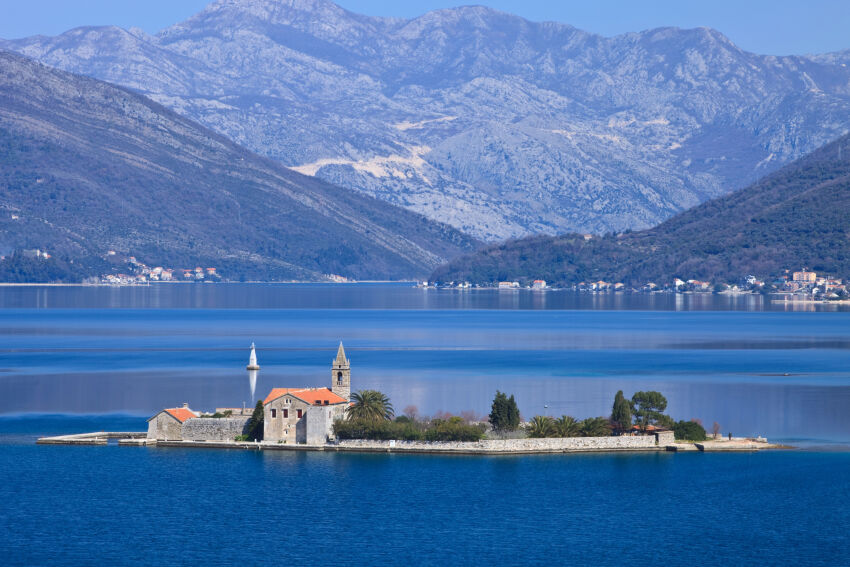
Perhaps the most interesting place in the Kotor Bay, only 147 meters long and 80 wide, is the Our Lady of Mercy Island (Gospa od Milo). Almost the entire island is occupied by a convent, surrounded by a stone wall with a towering campanile and a church. The monastery and church were founded at the end of the XV century and belonged to the Franciscan Order for a long time.
The Church of Our Lady of Mercy is considered to be one of the main churches of the country. People say that walls of the church were painted by Tripo Kokolya, the great painter of the XVII century. In addition to the frescoes, the church contains many other precious relics.
How to get there. You can easily get there. Take a group tour around the bay with a visit to the island or rent a boat in Perast.
The entrance is free. The price for a guided tour has to be confirmed on site.
Conclusion
Montenegro can surprise even those spoiled tourists who have traveled around the world. Here, under the incredibly blue sky, travelers will find countless treasures of the country: ancient fortresses and monasteries, cultural and historical monuments, natural resources and landscapes that will take your breath away and bring tears to your eyes. And if fate brought you to Montenegro, be sure to discover as many of its treasures as possible.
Make a pilgrimage to Ostrog, this challenging journey will strengthen your body and mind. Admire the beauty of the Piva Canyon, swim in one of the lakes of Durmitor, climb the monumental wall of the Sveti Ivan Fortress to enjoy the beauty of the Kotor Bay. Anyways, you’re free to choose the places to visit in Montenegro. Every traveler will make sure that this country is a real storehouse of emotions, impressions and amazing findings.

